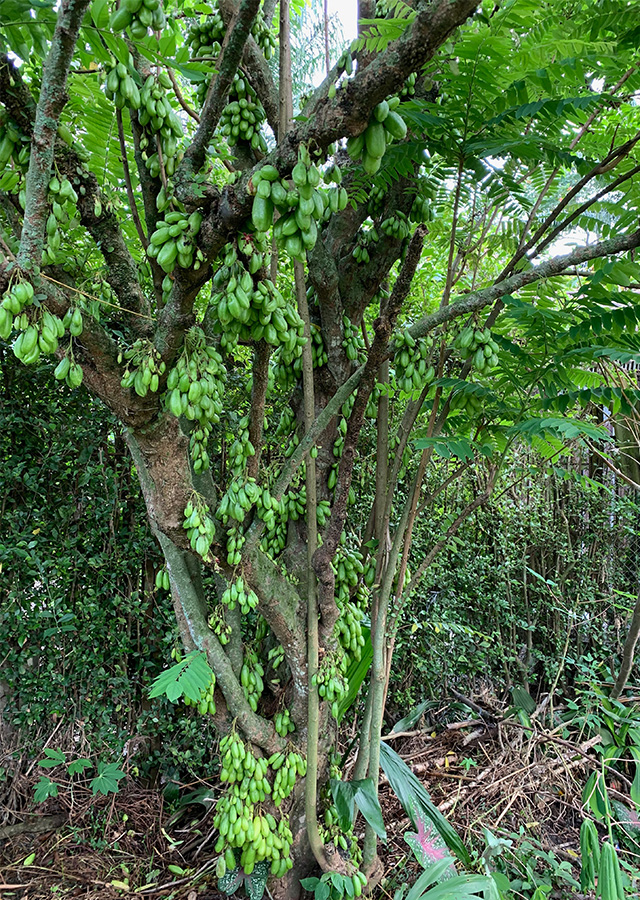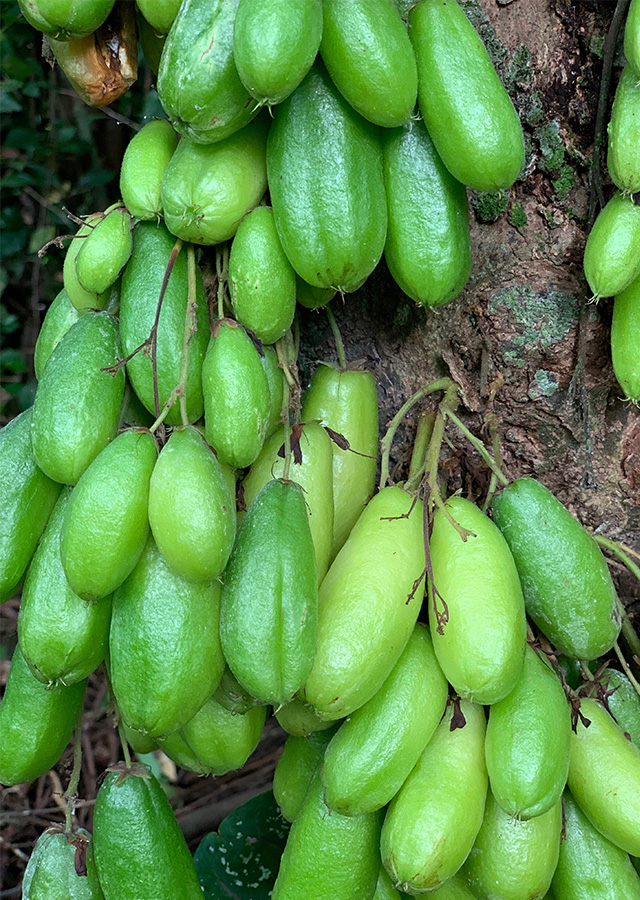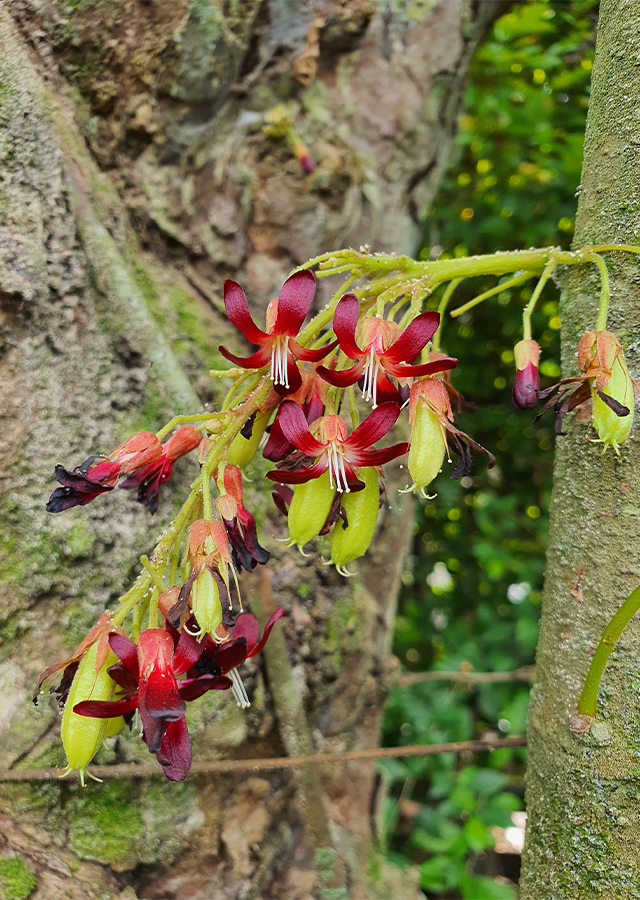Cucumber Tree
Averrhoa bilimbi L.
Oxalidaceae
Location in our garden
Orchard



Synonym
Averrhoa obtusangula Stokes
Habitus
Trees. A small perennial tree, grows up to 4 to 10 m high, diameter not so large about 30 cm.
Part Used
Leaves
Flowers
Fruit
Growing Requirements
Full Sunshine
Drought Resistant
Habitat
Forest
Overview
Averrhoa bilimbi is native to Southeast Asia, but has now been found to flourish in the tropics. This plant is an Indonesian endemic plant thought to originate from Maluku. Throughout Indonesia , Thailand, Malaysia , the Philippines, Sri Lanka, Bangladesh and Myanmar, the tree is cultivated or considered semi-wild. The plant is widely used for treatment as a medicinal plant. Sections of the plant that are sometimes used are the leaves, flowers and fruit. The fruit is a strong vitamin C source.
Vernacular Names
Bilimbi (English, Danish, India, French Guiana, Brazil, Catalan, Spanish), Blimbing (Dutch, Malay), Bimbling plum (Jamaica), Birinbi (Japanese), Blimblim (French), Bilimbibaum (German), Blimblim (French), and Taling pling (Thai), Belimbing wuluh (Java, Indonesia).
Agroecology
Compared to carambola, cucumber tree is a warm, tropical plant, very cold intolerant and does best in areas with uniformly distributed rainfall throughout the year, but with a dry season of 2-3 months. It grows from near sea level up to an altitude of 750 m. It grows from sandy to calcareous soil on a wide variety of soils, does best with a lot of organic matter and a pH of 5.5-6.5 on rich , well-drained, sandy-loam or clayey loam.
Morphology
- Stems - short with sparse thick branches.
- Leaves - alternate, densely crowded, 30-60 cm long with 11-37 leaflets, green, short petiole, ovate or oblong to lanceolate, medium-green on the upper surface, pale on the underside, obliquely rounded at the base and acuminate on the tip. Odd pinnate compound leaves, pointed end, flat edge, 2-10 cm long, wide 1-3 cm, the colour is green, the bottom surface lighter colour.
- Flowers - borne in axillary ramiflorous (on branches) or cauliflorous panicles (on the trunk). The flowers small red like stars and clustered.
- Fruits - glossy with a thin skin, green turning to yellowish green or white when ripe, juicy and very acid. The fruit is oval.
Cultivation
Vegetative (by seeds) and generative propagation (by stem cutting, grafting, budding).
Chemical Constituents
Format acid, glucoside, peroxide, tannins, saponins, amino acid, citrate acid, phenolic compounds, cyaniding 3-o-h-D-gluoside, flavonoids, triterpenoids, oxalate acid, pectin, gallate acid, ferulic acid.
Traditional Medicinal Uses
- For the prevention and treatment of hyperlipidemia, antibacterial and anti-scorbutic activities are used.
- The anti-atherogenic index and HDL-cholesterol / total cholesterol ratio were substantially increased, but LDL-cholesterol and total cholesterol concentrations were not affected.
- Reduced levels of kidney lipid peroxidation and oral anti-diabetic treatment.
- In tropical Asia: traditional cough, cold, itching, acne, boils, rheumatism, scurvy, syphilis, diabetes , hypertension and whooping cough medicine.
- In Thailand, leaves are used externally to avoid scratching, to treat syphilis, to cure beriberi, biliousness and coughs when taken internally fresh or fermented.
- In Malaysia, as a remedy for venereal diseases, new or fermented leaves are used. The infusion of leaves is used as a cough cure and as a tonic during childbirth. Leaf decoction is used to alleviate rectal inflammation as a treatment and tends to be effective against cough and thrush.
- In the Philippines, the warm paste of the leaves is used for pruritus or for scratching, swelling of the mumps and rheumatism, and for skin eruptions.
- In Java, inflammation of the rectum, mumps, rheumatism and pimples, applied to bites of poisonous animals, is handled with leaf decoction. Flower infusion is used in thrush, cold, and cough treatment.
- In India, the fruit is used as an astringent stomach, coolant, and fever reducer. For small instances of bleeding from the intestines, liver, and internal haemorrhoids, syrup is used.
Part Used
Reference Sources
- Lim, T.K. (2012). Edible Medicinal and Non-Medicinal Plants: Vol. 1, Fruits. Springer. DOI 10.1007/978-90-481-8661-7_3. (pp.448-453).
- Stuart Xchange. (2017). Philippines Medicinal Plants. Averrhoa bilimbi L. http://www.stuartxchange.com/Kamias.html 20-07-2020.
- Aseptianova, Yuliany EH. 2020. Counseling about the Benefits of Averrhoa bilimbi L. as a Health Plant in Kebun Bunga Sub-district, Sukarami District, Palembang. Abdihaz: Jurnal Pengabdian pada Masyarakat. 2(2):52-56. DOI: https://doi.org/10.32663/abdihaz.v2i2.910. 30 November 2021.
- Elfidiah, Kharismadewi D, Yuliwati E, 2020. Wuluh starfruit (Averrhoa bilimbi L.) leaves extract as green corrosion inhibitor in reinforced steel. The 8th Engineering International Conference 2019 Journal of Physics: Conference Series 1444 (2020) 012003 IOP Publishing doi:10.1088/1742-6596/1444/1/012003. 30 November 2021.
- Insan RR, Faridah A, Yulastri A, Holinesti R. 2019. Using Belimbing Wuluh (Averhoa bilimbi L.) As A Functional Food Processing Product. Jurnal Pendidikan Tata Boga dan Teknologi, Vol (1): pp. 47-55, DOI: 10.2403/80sr7.00. 30 November 2021.
- Ismail S, Marliana E, Kosala k. 2019. Effect of pH increasing of Wuluh star fruit (Averrhoa bilimbi L.) juice on vasodilatation activity. ICMSC2018. IOP Conf. Series: Journal of Physics: Conf. Series 1277 (2019) 012017 IOP Publishing doi:10.1088/1742-6596/1277/1/012017. 6 p. 30 November 2021.
- Saraswati RA, Setyaningsi E. 2018. Potensi tanaman Belimbing Wuluh (Averrhoa bilimbi) terhadap beberapa penyakit pada system cardiovascular. Seminar Nasional Pendidikan Biologi dan Saintek III (2018) 155 – 160. 30 November 2021.
- Yanti S, Vera Y. 2019. Skrining Fitokimia Ekstrak Daun Belimbing Wuluh (Averrhoa Bilimbi). INDONESIAN HEALTH SCIENTIFIC JOURNAL 4(2): 41 – 46. 30 November 2021.
- Zulkahfi, Suparmin S, Suparmin S, dan Arif A. 2017. Pengendalian Serangan Rayap Tanah Coptotermes sp. Menggunakan Ekstrak Daun Belimbing Wuluh (Averrhoa bilimbi L). Hasanuddin Student Journal. Vol. 1(1): 1-8. E-ISSN: 2579-7867. 30 November 2021.


